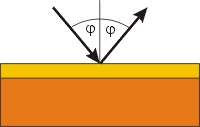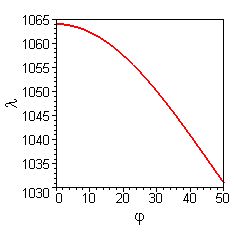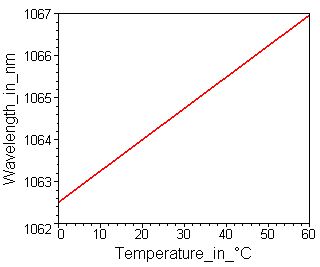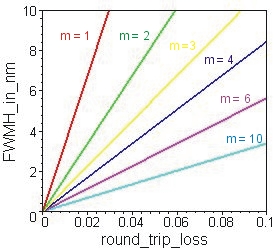Resonant saturable absorber mirror RSAM-1064-25.4s
RSAM-1064-25.4s resonant saturable absorber mirror, λ = 1064 nm, modulation depth ΔR = 90 %, low intensity reflectance < 1%, FWHM = 25 nm, relaxation time τ ~ 9 ps chip size: 4mm x 4mm, soldered on the center of a gold-plated Cu-cylinder with 25.4 mm.
|
RSAM - Resonant Saturable Absorber
Mirror
|
|||||||
| > | Contents | ||||||
| > | How does a RSAM work? | ||||||
|
Important parameters of the RSAM are the |
|
||||||
| > | RSAM applications | ||||||
The main applications for RSAMs are:
|
|||||||
| > | Resonance wavelength | ||||||
| Influence of the angle of incidence | |||||||
| The resonance wavelength l of the Gires傍ournois interferometer depends on the angle of incidence j and is given by | |||||||

|
eq.(1) | ||||||
| with | |||||||
| l | resonance wavelength of the interferometer | ||||||
| n | refractive index of the absorbing spacer layer |
|
|||||
| d | thickness of the absorbing spacer layer | ||||||
| m | order of the resonance; m = 1, 2, 3, .... | ||||||
| j | angle of incidence on the RSAM | ||||||
| In case of a perpendicular beam incidence the first order resonance wavelength is simply l = 2nd. |
|
||||||

|
Resonance wavelength l
of a RSAM with l(0) = 1064 nm and n = 3.1 after eq. (1) 
|
||||||

|
Resonance wavelength for parallel polarized light at different angles of incidence | ||||||

|
Resonance wavelength for perpendicular polarized light at different angles of incidence | ||||||
| Influence of the temperature | |||||||
| There is also a temperature influence on the resonance wavelength l. The temperature dependency of the optical thickness nd of the absorbing spacer layer, which governs the resonance wavelength l, is mainly determined by the refractive index. The influence of the thermal expansion of the layer thickness is negligible. | |||||||
| The change of the resonance wavelength l with the temperature can be calculated by | |||||||
|
|
eq.(2) | ||||||
| with | |||||||
| l (T) | resonance wavelength at temperature T | ||||||
| l (T0) | resonance wavelength at reference temperature T0 | ||||||
| 1/n*dn/dT | ~ 7.5x10-5K-1, temperature coefficient of the refractive index | ||||||
| T0 | reference temperature | ||||||
| T | working temperature | ||||||

|
Resonance wavelength l of a RSAM
with l(0) = 1064 nm after eq. (2) |
||||||
| > | Bandwidth | ||||||
| The bandwidth Dl of the interferometer resonance dip is gouverned by the round trip loss l of the wave inside the cavity and can be estimated in case of small losses l << 1 by | |||||||
| Dl = l (1 - rf + A)/(m π) = ll/(m π) | |||||||
| with | |||||||
| Dl | bandwidth FWHM (full width at half maximum) | ||||||
| l | resonance wavelength of the interferometer | ||||||
| (rf)2 = Rf | reflectance of the front mirror (back mirror reflectance Rb = 1) | ||||||
| A | single pass absorptance of the spacer layer | ||||||
| m | order of the resonance; m = 1, 2, 3, .... | ||||||
| l | round trip loss: 1 - rf + A |
|
|||||
| Dl for RSAM at l = 1064 nm |

|
|
|||||
| RSAM, impedance matched at
l = 1064 nm with front mirror reflection rf
= 0.97, unsaturated absorption of A = 1.5% and resonance order m = 4 .jpg)
|
|
||||||
| > | Saturation intensity | ||||||
| The RSAM is a strong nonlinear optical device. The
absorptance A of the absorber layer and the reflectance R of the RSAM depend
on the incoming light intensity I. Due to the resonance condition of the
Gires傍ournois interferometer at the working wavelength the effective
saturation intensity Isat,eff of the device shifts by a factor of
about (p/F)2 (F - finesse of the Gires傍ournois
interferometer) to lower values in relation to the intrinsic material value
Isat, which is valid for non-resonant saturable absorber mirrors
(SAM). The absorptance A of a RSAM with a not too small finesse F > 10 can be estimated by |
|||||||

|
eq.(3) |
|
|||||
| with | |||||||
| A | absorptance | ||||||
| A0 | small signal absorptance (saturable absorption) | ||||||
| I | light intensity (measured in W/m2) | ||||||
| Isat | intrinsic material saturation intensity | ||||||
| F | finesse of the RSAM | ||||||
| The effective saturation fluence Fsat,eff of a RSAM can be estimated using the relaxation time t and the effective saturation intensity Isat,eff | |||||||

|
eq.(4) | ||||||
| with | |||||||
| Fsat,eff | effective saturation fluence of the RSAM | ||||||
| Isat,eff | effective saturation intensity of the RSAM | ||||||
| t | relaxation time of the absorber material | ||||||
With typical values for a non-resonant SAM
the relevant parameters for a RSAM with a finesse F = 20 can be estimated to
In this way the effective saturation values can be decreased to very low values at the expense of a small usuable spectral bandwidth. |
|||||||
| > | Intensity dependent reflectance | ||||||
| RSAM at l = 1064
nm with front mirror reflection rf = 0.97, unsaturated absorption of A = 1.5% and resonance order m = 4 
|
|
||||||
| > | Relaxation time | ||||||
|
The saturable absorber layer consists of a semiconductor
material with a direct band gap, which is slightly smaller than the photon
energy. During the absorption electron-hole pairs are created in the film.
The relaxation time t of the carriers is very
short due to fast non-radiative relaxation channels introduced by
low-temperature growth of the absorber layer. |
Recovery of the absorption A0 with a relaxation time t = 10 ps 
|
|
|||||
| A(t) = A0[1 - exp(-t/t )] | |||||||
| with | |||||||
| A(t) | time dependent absorption | ||||||
| A0 | small signal saturable absorption | ||||||
| t | time | ||||||
| t | relaxation time | ||||||
SAM basics - SAM FAQ - SAM brochure
|
||||||||||||||||||||||||||||||||||||||||
|
||||||||||||||||||||||||||||||||||||||||